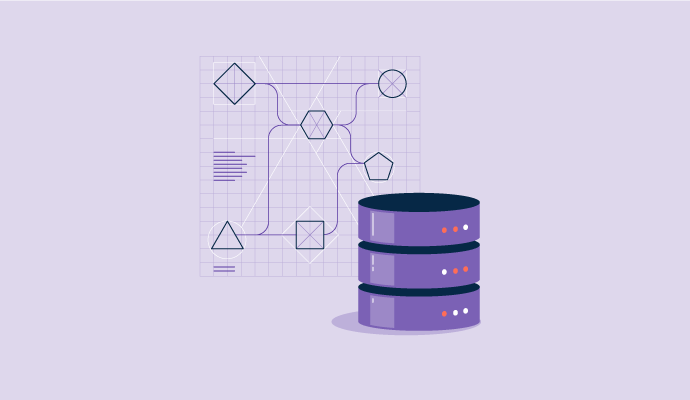Imagine, every time you order a product on Amazon, you get a prompt requesting your address and other details.
Wouldn't it affect your shopping experience? Amazon is aware of this and stores your data to make your shopping effortless. It links your customer ID with your address, phone number, and other details in its database.
Data modeling helps design such information systems to cater to business requirements.
What is data modeling?
Data modeling is a visual representation of data stored in information systems like databases or data warehouses. It visually shows the relationships between different data types and their formats and attributes.
Data modeling involves data architects working closely with business stakeholders and end-users. Business stakeholders provide feedback that helps set rules based on their and end users' requirements. These rules are then applied to design new systems or modify existing ones.
The data modeling process begins with capturing business’ and customers’ requirements. Data structures then implement rules that meet set conditions. Data modeling serves as a plan or blueprint that helps businesses create data systems for their unique needs.
Tip: Some businesses use data virtualization software to give their teams unified data access.
Data models evolve as business needs change. They help design the IT architecture by setting a formal collection process and conceptualizing data systems, rules, attributes, and relationships. They also rationalize data design that programmers create on an ad-hoc basis. Many organizations use data mapping tools that provide a graphical display of data, helping end users visualize complex mapping relationships.
The primary objective of creating a data model is to:
- Ensure that data objects are covered and adequately represented to avoid faulty reports
- Help design information systems at conceptual, logical, and physical levels
- Provide a clear picture of data objects necessary to design and create an information system
- Define relational tables, primary and foreign keys, and stored procedures
- Allow quick, easy, and cost-effective IT infrastructure upgrade in the long run
Types of data modeling
Data modeling connects data items and helps data architects visualize storage needs in a database. Below are the three main types of data modeling.
Conceptual data modeling
Data architects use a high degree of abstraction while designing information systems. Conceptual data modeling helps you visualize and create such systems, identify data items, and understand their relationships.
It allows businesses to classify data types, configure relevant rules, and include security and data integrity requirements. Conceptual data models help stakeholders understand business needs and enable architects to create logical data models with more granular detail.
Logical data modeling
Logical data models are less abstract and describe the data from a technical perspective. They provide details about data types, their lengths, relationships with entities, and concepts that help businesses arrive at a detailed representation of the database design.
Logical data modeling doesn't provide information on technical system requirements. Data architects prefer using logical models in data-oriented projects such as designing a data warehouse. Implementing one conceptual data model may require several logical data models. Business analysts and data architects generally use this stage to develop a technical map of data structures and rules.
Physical data modeling
Physical data modeling helps data architects get a schema for physically storing data within a database. Schema is a representation of a plan in form of an outline or model. This data model describes implementing information systems using a specific database management system (DBMS). It creates tables and fields to showcase the relationships between entities and primary and foreign keys.
Physical data models offer the least abstract design of implementing the system for specific applications and databases. Database administrators and developers use this model to implement databases.
¿Quieres aprender más sobre Software de Virtualización de Datos? Explora los productos de Virtualización de Datos.
Data modeling process
The data modeling process is a standard workflow to evaluate the business stakeholders' data processing and storage requirements. It allows data architects to design information systems with precise methods to organize data, rules, and relationships that connect different attributes, data types, and formats.
Different data modeling techniques follow different conventions that suggest representing data using multiple symbols and arrangements and conveying business requirements.
A typical data modeling workflow includes:
- Identifying entities. To start the modeling process, you need to identify different entities, concepts, or events in the data set. Ensure that each entity is cohesive and logically discrete from others.
- Determining properties. Properties are key factors that make entities discrete. These properties are called attributes and are unique to different entities. For instance, a "consumer" entity may have attributes such as phone number, shipping address, and more.
- Understanding relationships among entities. Your data model’s first draft identifies the relationships between different entities. In e-commerce, a "customer" entity is related to another entity, "product," where the relationship can be "order placed". Data architects usually document these relationships using unified modeling language (UML).
- Mapping attributes to entities. This data modeling step ensures that data models illustrate how businesses use and process the data. Companies can choose data modeling patterns such as design or analysis patterns based on their needs.
- Deciding on the degree of normalization. Data architects use the normalization technique to organize data models by assigning numerical identifiers, called keys, to groups of data without any repetition. This helps reduce storage requirements but can increase query performance costs.
- Finalizing the data model. Repeat and validate the above steps to establish an iterative data modeling process. Optimize and refine them as business needs change.
Data modeling techniques
Although many techniques help create data models, the underlying concept remains the same.
Hierarchical data modeling
IBM developed hierarchical data modeling in 1960. It's a tree-like structure with one parent (root) node connected to several child nodes. This is an example of one-many relationships that may not be suitable to illustrate complex data sets.
Modern data sets have many-to-many relationships, making the hierarchical data modeling approach unsuitable for the current data-driven world. Moreover, the one-to-many relationship structure makes it challenging for companies to gain granular insights from the information gathered.
Relational data modeling
The relational data modeling technique supports analytics initiatives on complex data sets (like big data). It organizes data in related tables. Organizations maintain these relationships for better consistency and integrity by using structured query language (SQL) to obtain and record tables.
Edgar F. Codd proposed relational databases in 1970. They’re still relevant for modeling data sets in complex data analysis.
Entity-relationship data modeling
Entity-relationship (ER) data modeling provides a logical structure to create relationships between data points depending on software development needs. It includes entity types (things of interest) and describes relationships that can exist between them.
This technique is different from the relational data modeling technique. It caters to specific business processes in a set order to complete a task while minimizing data privacy risks.
Peter Chen introduced ER data modeling technique in 1976, which revolutionized the computer science industry.
Object-oriented data modeling
The object-oriented data modeling technique groups objects into class hierarchies, representing the real world. Several object-oriented programming languages use it to cover abstraction, inheritance, and encapsulation features. Data and their relationships are grouped together in one structure, referred to as an object. These objects have multiple relationships between them.
This technique enables data scientists to analyze and present complex data structures. It's also called a post-relational database model.
Dimensional data modeling
Dimensional data modeling allows businesses to retrieve data from data warehouses. It represents data in cubes or tables for slicing and dicing for better analysis and data visualization.
With dimensional data modeling, users can perform in-depth analysis by evaluating data from different perspectives.
Businesses generally adopt two types of dimensional data modeling techniques:
- Star schema: Uses facts and dimensions to represent relationships
- Snowflake schema: Leverages multiple dimension levels to facilitate complex data analysis
Network technique
The network model represents objects and their relationships to entities in a flexible way. It allows a child record can have more than one parent. It's inspired by the hierarchical model but offers an easier way to convey complex relationships.
The network technique is a precursor to the graph data structure. You can link one record to multiple parent records using this technique.
Benefits of data modeling
Data modeling enables business analysts, data architects, and other stakeholders to understand the relationship between different data items and helps them create an information system that meets specific business needs.
Below are some benefits of data modeling for businesses.
- Improves data quality. Data modeling not only streamlines the data flow but also enhances data quality. It provides a blueprint for data analysts to better understand the relationship between data items, allowing them to extract data without worrying about its quality. Analysts use this blueprint to understand the best possible approaches to design data systems and avoid premature coding.
- Reduces costs. Analysts follow a designated roadmap to collect and analyze information with data modeling. In the absence of data modeling, a business might revamp its data collection techniques, attributing to additional operational costs. It also helps you catch errors and oversights when they're easier to fix.
- Enhances collaboration. Data modeling eases communication between developers and business intelligence teams, resulting in better cooperation and reduced database development errors. It clearly defines the scope and provides something tangible, bringing different teams on the same page.
- Increases consistency. Data modeling helps businesses ensure documentation and system design consistency, enabling effective implementation. Documentation allows long-term system maintenance by helping teams understand important abstractions and ideas.
Data modeling challenges
Businesses face various challenges with data modeling initiatives. These challenges can sometimes result in faulty data analysis and false insights.
Some of the common data modeling challenges are:
- Identifying inaccurate data contributors. The entire data modeling process falls apart if the data sources are inaccurate. Businesses should ensure they process accurate data to draw meaningful conclusions.
- Inconsistent naming standards. Poor naming conventions can stage hurdles in the data modeling roadmap, especially when data comes from multiple sources. It's essential to follow a standardized naming convention for all tables, constraints, columns, and measures. For example, if there are two columns: "production", and "material". The first column lists "production_costs" and "Vendors" in two rows, and similarly second column lists "material_costs" and "material_vendors". Here, "Vendors" is inconsistent with the naming convention, and should ideally be "production_vendors" to follow the standard.
- Ignoring small data sources. Critical business data is stored in various places, including the often-overlooked small sources. Analyzing incomplete data sets results in improper analysis and faulty insights. Businesses should centralize data and eliminate silos to model data successfully and drive actionable insights.
Formalize data modeling
Creating a formal data modeling process allows businesses to decide on data collection workflows, helping them set an efficient process that serves business needs. This enables you to save extra operational costs and effectively meet business needs.
Learn more about database management systems and how they help organizations create, maintain, and manage databases.

Sagar Joshi
Sagar Joshi is a former content marketing specialist at G2 in India. He is an engineer with a keen interest in data analytics and cybersecurity. He writes about topics related to them. You can find him reading books, learning a new language, or playing pool in his free time.

